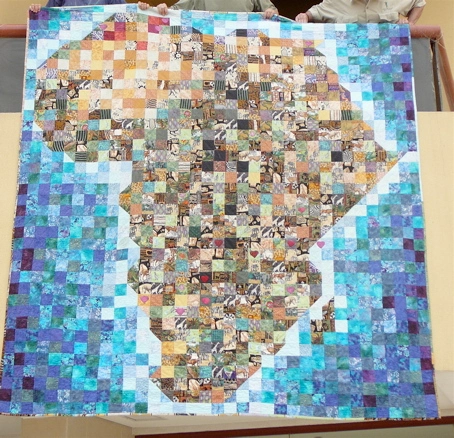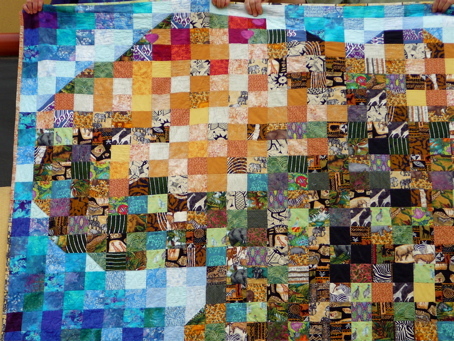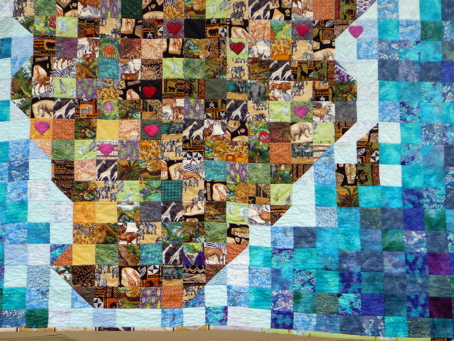Kaleidescope Play
24 September 2007
Careful cutting and piecing are key to the success of every Kaleidescope. If you will take your time in the cutting and piecing stages, your blocks will be perfect, every time.
Cutting for a level one Kaleidescope, two fabrics:
Cut 5 strips 4 1/2 inch wide, width of fabric, from light fabric and 5 from dark fabric.
Cut 3 strips light and 3 strips dark 3” by the width of the fabric, cross cut into 3” squares,
slice diagonally.
Using template or ruler, cut dark and light wedges for Kaleidescope. You should get 20 per strip, minimum. It takes four light and four dark wedges to make each Kaleidescope block. So one strip makes about enough for that color in 5 blocks.
If you are only doing two colors, make two piles of wedges, one dark and one light. If you are doing a more complicated Kaleidescope, you may want to choose wedges for each block individually, either before you start or as you go.
Piecing:
I usually put the light piece on top of the dark piece; it helps me remember, every time, so I don’t have three sets going one way and a fourth set going another! I also prefer to sew from the larger end toward to bottom end, as it seems to get stuck in the feed dogs less often.
Then you put two sets of twos together. Dovetail the center seams; push them up tightly together, and stitch. This time, from the wide end, it will be dark on top of light for both sets.
You probably think it will be tricky sewing eight pieces together at the center of the circle, but there is a trick. lay them together, right sides together, and where the centers will meet, push the seams together, top seam going one way, bottom seam the other. If you make the junction nice and tight, your kaleidescopes will be perfect, or nearly perfect, every time.
You can pin if it makes you feel more secure, but remember to pull the pin out – don’t sew over a pin!
Some very respectable authors (Marty Mitchell for one) will tell you to sew corner squares on before you sew the wedges together. Others – equally respectable – say to sew the corner pieces on after. For me, if I were making a simple two color kaleidescope, I might sew the corners on as I go along. But because I play a lot with color gradations, and with larger patterns, I wait until the blocks are all finished, and then I put the corners on. It goes very quickly, and it gives me more opportunity to play with the lines.
(A quilting friend who is very precise says that the 3″ square does not work for her, that she needs a 3 1/4″ square to get the corner pieces big enough for a generous block. She wants all her blocks to equal 8″. It is not so important to me that the blocks be 8″ as that they all be the same. If you want to cut your squares 3 1/4″ too, be my guest. I am guessing that the reason the 3″ squares work for me is that I put the corners on AFTER the wheels are put together, every time, because most of the time I am working with color placements, and the corner colors can become critical in the advanced level kaleidescopes.)
Marti Mitchell says to match up the corners, not to just make the corner point to the center. I find that making the corners point to the center works just fine, but you should probably do it the way Marti Mitchell says to do it, unless you like the other way better.
When all your blocks are complete, trim them to a uniform size. It may not be exactly 8 inches, it may be 7 1/2 or 7 3/4 or 7 7/8. It doesn’t matter, as long as they are the same size.
Lay the blocks out, so you will be sure you have the rows in the right order, then sew each row together, and sew it to the rows you have finished. Carefully match all seams. Check after each row to make sure all seams match before going to the next row. Put on borders if you wish, or bind and quilt.
Hint: Because I like a Kaleidescope quilt to be symmetrical, I always do Kaleidescopes in odd numbers, so that the corners will all be the same and the sides will be the same. It isn’t a hard and fast rule, it’s only my preference. But that’s why I chose a practice size of 25 blocks, so that you would have enough blocks to practice, and then a quilt big enough for a baby quilt to give away. And it would be symmetrical!
Level two kaleidescope – playing with analogous colors:
Level three kaleidescope: playing with lines, using kaleidescope motion but taking some of the colors outside the kaleidescope rules – hoping that the alternation of light and dark MOST OF THE TIME will carry the movement while still breaking out of the rigid light/dark rules. 😉 This is where even color in the corners becomes critical, and you really really need a project board:
This is going to be my husband’s Christmas present. I have to trust that he finds my quilt blog so boring he never checks it! And Woooo Hooooo, this was a real challenge for me, and a lot of fun. African animals, African people, African colors, several fabrics from the Sudan, Senegal, Tunisia and South Africa – oh, I had so much fun with this one.
There is another level, level four. A friend is going there – warping the kaleidescope block. I’m not there yet.






